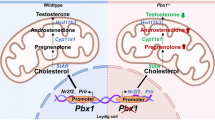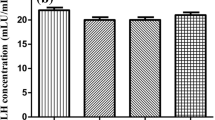Abstract
Cyclin-dependent kinase inhibitor 1B (Cdkn1b, p27) plays important regulatory roles in many cellular processes. p27 is highly expressed in the mouse testis, but its roles and underlying mechanisms for testosterone synthesis and secretion remain not well understood. In the current study, we found that p27 located in Leydig cells and Sertoli cells of adult mouse testis. To explore the function of p27 in Leydig cells, p27 inhibitor and activator were injected into the adult mice, primary Leydig cells and TM3 cells. Our in vivo and in vitro results showed that change in the expression of p27 significantly alters the testosterone in both globe serum and culture medium. Meanwhile, the steroidogenesis-related gene expression was significantly regulated too. Moreover, our in vitro study showed that luteinizing hormone (LH) significantly increased p27 mRNA levels. Furthermore, our results proved that altering the mRNA expression of p27 leads to the synchronized changes of Lhcgr, Star, Cyp11a1, Hsd3b6, Cyp11a1, and Hsd17b3. Alterations of p27 also result in synchronously changes of RAF1 and ERK1/2 phosphorylation. These findings indicate that p27 plays vital roles in LH-induced testosterone production, providing a novel mechanism that p27 acts as an upstream molecule to elevate ERK1/2 phosphorylation to promote the expression of StAR and other cholesterol-metabolizing enzymes.





Similar content being viewed by others
References
Aleksandar Z, Baburski SAA, Kostic TS (2019) Luteinizing hormone signaling is involved in synchronization of Leydig cell’s clock and is crucial for rhythm robustness of testosterone production. Biol Reprod 100:1406–1415
Baker BA, Morley R, Lucas A (1988) Plasma testosterone in preterm infants with cryptorchidism. Arch Dis Child 63(10):1198–1200
Baker PJ, O’Shaughnessy PJ (2001) Role of gonadotrophins in regulating numbers of Leydig and Sertoli cells during fetal and postnatal development in mice. Reproduction 122(2):227
Baker PJ, Sha JA, McBride MW, Peng L, Payne AH, O’Shaughnessy PJ (1999) Expression of 3beta-hydroxysteroid dehydrogenase type I and type VI isoforms in the mouse testis during development. Eur J Biochem 260:911–917
Barakat B, O’Conner AE, Gold E, de Kretser DM, Loveland KL (2008) Inhibin, activin, follistatin and FSH serum levels and testicular production are highly modulated during the first spermatogenic wave in mice. Reproduction 136:345–359
Beattie MC, Adekola L, Papadopoulos V, Chen H, Zirkin BR (2015) Leydig cell aging and hypogonadism. Exp Gerontol 68:87–91
Catzavelos C, Bhattacharya N, Ung YC, Wilson JA, Roncari L, Sandhu C, Shaw P, Yeger H, Morava-Protzner I, Kapusta L (1997) Decreased levels of the cell-cycle inhibitor p27Kip1 protein: prognostic implications in primary breast cancer. Nat Med 3:227–230
Chen H, Wang Y, Ge R, Zirkin BR (2016) Leydig cell stem cells: identification, proliferation and differentiation. Mol Cell Endocrinol 445:65
Chu IM, Hengst L, Slingerland JM (2008) The Cdk inhibitor p27 in human cancer: prognostic potential and relevance to anticancer therapy. Nat Rev Cancer 8:253–267
Dong F, Agrawal D, Bagui T, Pledger WJ (1998) Cyclin D3-associated kinase activity is regulated by p27kip1 in BALB/c 3T3 cells. Mol Biol Cell 9:2081–2092
Dufau ML, Catt KJ (1978) Gonadotropin receptors and regulation of steroidogenesis in the testis and ovary. Vitam Horm 36:461–592
Evaul K, Hammes SR (2008) Cross-talk between G protein-coupled and epidermal growth factor receptors regulates gonadotropin-mediated steroidogenesis in Leydig cells. J Biol Chem 283:27525–27533
Fero ML, Rivkin M, Tasch M, Porter P, Carow CE, Firpo E, Polyak K, Tsai LH, Broudy V, Perlmutter RM, Kaushansky K, Roberts JM (1996) A syndrome of multiorgan hyperplasia with features of gigantism, tumorigenesis, and female sterility in p27(Kip1)-deficient mice. Cell 85:733–744
Ge R, Hardy MP (2007) Regulation of Leydig cells during pubertal development. Humana Press, pp 55–70
Ge R-S, Dong Q, Sottas CM, Papadopoulos V, Zirkin BR, Hardy MP (2006) In search of rat stem Leydig cells: identification, isolation, and lineage-specific development. Proc Natl Acad Sci 103:2719–2724
Goldman AL, Bhasin S, Wu FCW, Krishna M, Matsumoto AM, Jasuja R (2017) A reappraisal of testosterone’s binding in circulation: physiological and clinical implications. Endocr Rev 38(4):302–324
Gyles SL, Burns CJ, Whitehouse BJ, Sugden D, Marsh PJ, Persaud SJ, Jones PM (2001) ERKs regulate cyclic AMP-induced steroid synthesis through transcription of the steroidogenic acute regulatory (StAR) gene. J Biol Chem 276:34888–34895
Hall DPF (1986) Cytochromes P-450 and the regulation of steroid synthesis. Steroids 48:131–196
Hornakova L, Vrbovska T, Pavl’Ak M, Valencakova-Agyagosova A, Hajurka J (2017) The evaluation of blood concentrations of testosterone, 17β-oestradiol and anti-Mu¨llerian hormone in dogs with cryptorchidism and testicular tumours. Pol J Vet Sci 20:677–685
Iconaru LI, Ban D, Bharatham K, Ramanathan A, Zhang W, Shelat AA, Zuo J, Kriwacki RW (2015) Discovery of small molecules that inhibit the disordered protein, p27(Kip1). Sci Rep 5:15686
Tremblay, Jacques J (2018) Molecular regulation of steroidogenesis in endocrine Leydig cells. Steroids 103:3–10
Kahán Z, Gardi J, Nyári T, Földesi I, Hajnal-Papp R, Ormándi K, Lázár GR, Thurzó L, Schally A (2006) Elevated levels of circulating insulin-like growth factor-I, IGF-binding globulin-3 and testosterone predict hormone-dependent breast cancer in postmenopausal women: a case-control study. Int J Oncol 29(1):193–200
Kwang-Hoon S, Jae-Il P, Mi-Ock L, Jaemog S, Keesook L, Hueng-Sik C (2001) LH induces orphan nuclear receptor Nur77 gene expression in testicular Leydig cells. Endocrinology 142:5116–5123
Laura B, Maloberti PM, Gomez NV, Poderoso C, Gorostizaga AB, Mori Sequeiros Garcia MM, Acquier AB, Mariana C, Mendez CF, Podesta EJ (2011) MAPK phosphatase-1 (MKP-1) expression is up-regulated by hCG/cAMP and modulates steroidogenesis in MA-10 Leydig cells. Endocrinology 152:2665–2677
Li C, Gao S, Chen S, Chen L, Zhao Y, Jiang Y, Zheng X, Zhou X (2018) Differential expression of microRNAs in luteinising hormone-treated mouse TM3 Leydig cells. Andrologia:50
Li CF (2013) Pharmacological inactivation of Skp2 SCF ubiquitin ligase restricts cancer stem cell traits and cancer progression. Cell 154:556–568
Lin H, Hu G, Dong L, Dong Q, Mukai M, Chen B, Holsberger D, Sottas C, Cooke P, Lian Q (2009) Increased proliferation but decreased steroidogenic capacity in Leydig cells from mice lacking cyclin-dependent kinase inhibitor 1B. Biol Reprod 80:1232–1238
Lin H, Huang Y, Su Z, Zhu Q, Ge Y, Wang G, Wang CQF, Mukai M, Holsberger DR, Cooke PS (2015) Deficiency of CDKN1A or both CDKN1A and CDKN1B affects the pubertal development of mouse Leydig cells. Biol Reprod 92:77–77
Liu H, Yang Y, Zhang L, Liang R, Ge R-s, Zhang Y, Zhang Q, Xiang Q, Huang Y, Su Z (2014) Basic fibroblast growth factor promotes stem Leydig cell development and inhibits LH-stimulated androgen production by regulating microRNA expression. J Steroid Biochem Mol Biol 144:483–491
Makela JA, Koskenniemi JJ, Virtanen HE, Toppari J (2019) Testis development. Endocr Rev 40:857–905
Matfier JP (1980) Establishment and characterization of two distinct mouse testicular epithelial cell line. Biol Reprod 1:243–252
Matzkin ME, Yamashita S, Ascoli M (2013) The ERK1/2 pathway regulates testosterone synthesis by coordinately regulating the expression of steroidogenic genes in Leydig cells. Mol Cell Endocrinol 370:130–137
McCampbell AS, Mittelstadt ML, Dere R, Kim S, Zhou L, Djordjevic B, Soliman PT, Zhang Q, Wei C, Hursting SD (2016) Loss of p27 associated with risk for endometrial carcinoma arising in the setting of obesity. Curr Mol Med 16:252–265
Miller WL, Auchus R (2011) The molecular biology, biochemistry, and physiology of human steroidogenesis and its disorders. Endocr Rev 32:81–151
Nakayama K, Ishida N, Shirane M, Inomata A, Inoue T, Shishido N, Horii I, Loh DY, Nakayama K (1996) Mice lacking p27(Kip1) display increased body size, multiple organ hyperplasia, retinal dysplasia, and pituitary tumors. Cell 85:707–720
O'Hayre, M. , Eichel, K. , Avino, S. , Zhao, X. , & Gutkind, J. S (2017). Genetic evidence that β-arrestins are dispensable for the initiation of β2-adrenergic receptor signaling to erk. Science Signaling, 10(484).
Ohlander SJ, Lindgren MC, Lipshultz LI (2016) Testosterone and male infertility. Urol Clin N Am 43(2):195–202
Papadopoulos V, Miller WL (2012) Role of mitochondria in steroidogenesis. Best Pract Res Clin Endocrinol Metab 26:771–790
Polyak K, Lee MH, Erdjumentbromage H, Koff A, Roberts JM, Tempst P, Massagué J (1994) Cloning of p27Kip1, a cyclin-dependent kinase inhibitor and a potential mediator of extracellular antimitogenic signals. Cell 78:59–66
Selvage DJ, Loren P, Catherine R (2006) Role played by brainstem neurons in regulating testosterone secretion via a direct neural pathway between the hypothalamus and the testes. Endocrinology 147:3070–3075
Serge N, Tracey S, Parada LF (2000) A molecular basis for estrogen-induced cryptorchidism. Dev Biol 224:354–361
Shan L, Hardy DO, Catterall JF, Hardy MP (1995) Effects of luteinizing hormone (LH) and androgen on steady state levels of messenger ribonucleic acid for LH receptors, androgen receptors, and steroidogenic enzymes in rat Leydig cell progenitors in vivo. Endocrinology 136:1686–1693
Shiraishi K, Ascoli M (2008) A co-culture system reveals the involvement of intercellular pathways as mediators of the lutropin receptor (LHR)-stimulated ERK1/2 phosphorylation in Leydig cells. Exp Cell Res 314:25–37
Smith LB, Walker WH (2014) The regulation of spermatogenesis by androgens. Semin Cell Dev Biol 30:2–13
Sophie VR, Andrew W (2018) Salivary testosterone in relation to social cognition and social anxiety in children and adolescents with 47,XXY (Klinefelter syndrome). Plos One 13:e0200882
Stocco DM (2001) Tracking the role of a StAR in the sky of the new millennium. Mol Endocrinol 15:1245–1254
Takashi H, Mario AJE (2003) A constitutively active somatic mutation of the human lutropin receptor found in Leydig cell tumors activates the same families of G proteins as germ line mutations associated with Leydig cell hyperplasia. Endocrinology 144:3872–3878
Toyoshima H, Hunter T (1994) p27, a novel inhibitor of G1 cyclin-Cdk protein kinase activity, is related to p21. Cell 78:67–74
Yang Q, Al-Hendy A (2018) The emerging role of p27 in development of diseases. Cancer Studies and Molecular Medicine : Open Journal 4(1):e1–e3
Zirkin BR, Papadopoulos V (2018) Leydig cells: formation, function, and regulation†. Biol Reprod 99:101–111
Funding
This work was supported by the National Key Research and Developmental Program of China (2018YFC1003504), the Natural Science Foundation of China (31430083, 31772692), and the Project of the Priority Academic Program Development of Jiangsu Higher Education Institutions (PAPD).
Author information
Authors and Affiliations
Corresponding author
Additional information
Editor: Tetsuji Okamoto
Rights and permissions
About this article
Cite this article
Guo, H., Luo, X., Sun, L. et al. Cyclin-dependent kinase inhibitor 1B acts as a novel molecule to mediate testosterone synthesis and secretion in mouse Leydig cells by luteinizing hormone (LH) signaling pathway. In Vitro Cell.Dev.Biol.-Animal 57, 742–752 (2021). https://doi.org/10.1007/s11626-021-00545-x
Received:
Accepted:
Published:
Issue Date:
DOI: https://doi.org/10.1007/s11626-021-00545-x




